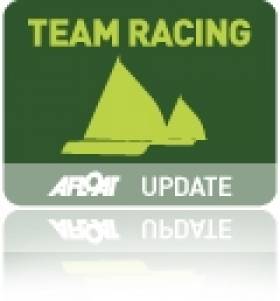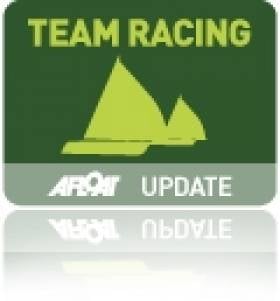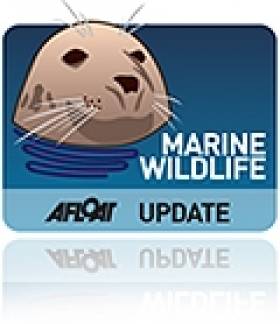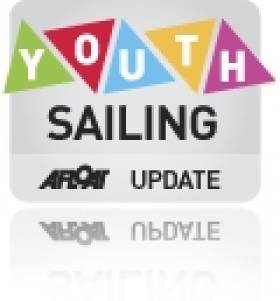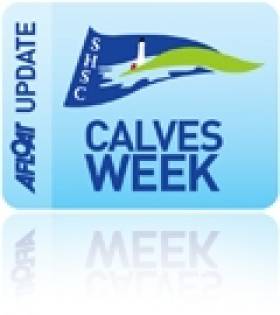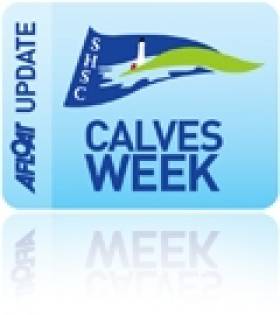Displaying items by tag: Schull
Although a town marina for Schull gets ever closer for the moment boaters make do with a quay and a 40-foot long pontoon in Schull Harbour, primarily used by small boats. It is a facility that makes embarkation and disembarkation easier.
#school team sailing – Racing in the shadow of a gale warning Schull Community College won the Irish Schools Team Racing Championships on home waters at the weekend.
14–teams competed in the event drawn Munster, Leinster, Connaught and two teams from the UK.
Reduced to a one day affair due to 30–knots winds from the south east, the hardy West Cork locals beat visitors Maudlin College (MCS) of Oxford 2-0 in the finals sailed on Saturday afternoon.
Second overall was Presentation College (PBC) in Cork.
Leinster School sailing champions Kilkenny College were third.
Teams were divided into two groups from there ranking at the regional events, with Schull 1, Rochestown College, St Andrews, Schull 2, Gonzaga, Rice College and MCS from the UK in Group 1.
PBC, Kilkenny, Belvedere, Schull 3, Scoil Mhuire, Mt Anville and Morespeed from the UK in Group 2.
Racing took place in 18 of the new team racing boats supplied for the Team Racing Worlds 2011 called the TR 3.6, with little or no breakages.
42 races were run in quick succession with the top two from each group going forward to the Semi Finals and Finals.
In the first Semi Final MCS (UK) were matched against Kilkenny College and the second Semi Final PBC were matched against Schull 1
Kilkenny and PBC matched up for the play off for Silver and Bronze, with PBC taking the Silver 2-1.
Both MCS and Schull were the winners with two wins each and went head to head for the overall result both these teams have meet each other before in two Finals over the last two years at the British Schools Team racing Nationals with one win each, so this was an important final for both teams. Schull came out the winners with two wins, putting them as favourites for the British Schools Nationals in July.
1st Schull Irish National Champions
2nd PBC
3rd Kilkenny
4th Joint/ Rochestown and Belvedere
Overseas Trophy MCS
12 Sailing Schools Line up for Schull's Team Championships
#schoolteamsailing – Current Munster school sailing champions Schull 1 will go head to head with Leinster champions Kilkenny College for the Irish title this weekend when the Irish Schools Sailing (ISSA) Team Racing National Championships takes place in Schull, West Cork. 12 teams have qualified from there regional events with two teams travelling from the UK.
The Fastnet Trophy will be awarded to the first Irish Team Gold, Silver and Bronze medals will be awarded to the first three Irish teams.
The FMOEC Trophy will be awarded to the first overseas Team.
The qualifying teams are:
Schull 1
Schull 2
Schull 3
PBC
Rochestown
Scoil Mhuire
Kilkenny College
Gonzaga
Belvedere
St Andrews College
Mt Anville
Rice
MCS
Morespeed
Download NOR for the event below
#youth sailing – David Harte of Schull Community College Sailing Club offers his views on how one secondary school in West Cork is contributing to youth sailing and the Irish dinghy scene.
I have taken on board, with interest, many of the recent letters, forums, and discussions on the present state of dinghy racing in Ireland. Whilst generating much food for thought, I would like to avail of the opportunity to mention the very positive input, that a small secondary school situated in the far south-west, contributes to the overall status of dinghy sailing, and, racing, in Ireland.
Schull Community College has 450 enrolled students, 98% of which, would come from a non-sailing background,. The College Sailing Club has 78 members. Introduction to sailing takes place in September when all 1st year students are afforded an opportunity to experience sailing. This would take the form of a fun day out with the goal that all students come back with a smile. Those interested in learning the skills, to whatever level or standard, are invited to become members of the Schull Community College Sailing Club.
The cost for membership is €100 for the year, or €150, for two, or more, family members. This fee covers Saturday sailing throughout the year (weather permitting), with instructors and coaches, and the use of a variety of dinghies to suit all skills.
Beginners are thought the skills of sailing without reference to the SBSS (ISA Small Boat Sailing Scheme). We intentionally do not use this scheme as we have found in the past, that students prioritise attainment of levels over skills.
The goals of each student are different, with some content to sail back and forth with their friends having fun, but using the proper skills to do so, while others are eager to advance to developing Team Racing skills. Progress to this stage can be achieved once the student has demonstrated a good understanding of the 5E's, and can sail around a course with little or no rudder. Saturday sailing, during the year, attracts an average of 30 sailors on a cold day to 50+ on a sunny day Team racing discipline is used at the school as it is an achievable goal with little or no personal resources required, with boats and coach supplied by the FMOEC.
"We intentionally do not use the ISA Small Boat Sailing Scheme as we have found in the past, that students prioritise attainment of levels over skills".
Students learn the advanced skills of sailing, an introduction to racing rules, and team work. A typical Saturday would involve, briefing, boat handling exercises, team racing, and de-briefing, as well as boat maintenance, and seamanship skills, etc. With team racing, students upskill rapidly, as competition for team places is continuous throughout the year. Most of the students would never have sailed outside of Schull Harbour, but, within a few years, clearly demonstrate a skill level, equal to, or above their peers from other clubs. When students reach transition year they have an extra days sailing on Wednesdays. At this stage students are divided into two groups, with one group learning to sail and the other learning the skills required to become a Dinghy Instructor. For instructorship, students attend VHF, First Aid, and Powerboat courses, and their pre-entry. At this stage, none of the students would have any SBSS levels, but, they would have the skills necessary to pass their pre-entry Most of these courses are subsidised by the FMOEC which allows the student to become an Instructor, without the burden of recourse to personal resources. Mainstream costs to fulfill all courses required to become an Instructor approximate in the region of €1,500, which, in my view, is completely ridiculous.
Most of the students who become instructors, are offered summer jobs at the centre, teaching the SBSS to the general public. Our courses run for nine weeks, and it is during this that our instructors see the downfall of the SBSS, with a sizeable percentage of students attending the courses showing more interest in the cert., rather than the skill. This in turn forces sailing clubs and centres to issue certs., as parents believe they have paid for the cert., and not the skills. Our team racing teams participate in many events throughout the year, ranging from the Munster Schools Team Racing Championships to the International Wilson Trophy.
A look at the results from last years 1st team, which consisted of six team members, of which, five came from a non-sailing background, demonstrates the achievement of the FMOEC syllabus. Irish National Champions, British U21 Champions British Schools Champions, Youth Helmsman Champion, Silver Senior Helmsman Championships, 4.7 National Champion and Silver Radial Championships. It would be easy to ascribe this success to 'an exceptional team', but, Schull teams have been Irish National Champions every year, except two, have won the British Schools Championships four times, and been in the top four over the last six years.
One may pose the question....'where do they go after they finish at Schull Community College, and, do they continue sailing?..... Follow up on team-racing participants, whether they go on to 3rd. level, or, otherwise, demonstrates a continuing healthy involvement in sailing activities. In 2011 the ITRA (Irish Team Racing Championships) were held in Schull and over 50% of the helms entered in the event were ex-Schull Community College.
In conclusion, it is my belief that the present state of dinghy racing in Schull (Ireland) is strong, and, demonstrably, getting stronger.
More on this subject of dinghy sailing here
Baltimore Whale Remains Dumped At Sea
#MARINE WILDLIFE - The carcass of the fin whale that died after being trapped in Baltimore Harbour two months ago has been towed out to sea after its presence in a conservation area attracted complaints.
According to the Irish Examiner, disappointment has been expressed by a local group in Baltimore who hoped to salvage the skeleton of the 65ft female fin whale, the remains of which have now been towed out beyond Fastnet Rock for disposal.
Last week Afloat.ie reported on claims from local resident Tom McCarthy, among others from the Schull area, that the whale carcass was creating a "rancid oil slick" with a "horrendous smell" in Roaringwater Bay, a Special Area of Conservation for marine wildlife that houses a grey seal breeding ground.
However, the Irish Whale and Dolphin Group (IWDG) - which was working with Baltimore residents on their plan to retrieve the bones with a view to displaying the skeleton in the town - criticised the decision by Cork County Council to dump the remains.
IWDG sightings co-ordinator Pádraig Whooley pointed the finger at "vested interests" exaggerating claims about health hazards, arguing that "towing it out to sea raises the very real possibility that [it] could simply wash up on the coast again."
The Irish Examiner has more on the story HERE.
Nine Wins Gives Lyden Junior All Ireland Sailing Title
#youthsailing – Nine wins from nine races gave Fionn Lyden the Junior All Ireland Sailing Championship this afternoon in Schull, West Cork. Scroll down to download full results as a pdf.
Lyden, a member of Schull's Youth Team that lifted the under 21 trophy at the Wilson trophy at West Kirby in the UK in May, capped off the 2012 season with the storming win in the locally built TR3.6 dinghy.
Conditions remained ideal for the Irish Sailing Association (ISA) event with a steady easterly breeze of between 10 and 12 knots on the windward leeward courses today.
Under the management of David Harte, racing got off to a good start at 10.30am and Fionn and his crew of Anna O'Regan were quick to take the lead yet again. Continuing their domination of the fleet, the duo from Schull Community College Sailing Club were unbeatable in the locally built boat TR3.6 dinghy as they won all three of the remaining fleet races putting them on 7 points entering the medal race followed by Finn Lynch and his crew Sean Donnelly on 24 points and Eoin Lyden and Darragh McCormack on 28 points in third place.
At 1.25pm the top 10 sailors, consisting of eight boys and two girls, crossed the start line for the last time. Fionn got off to a bad start but echoing his skill from the previous races, he sailed hard and rounded the first mark in first place. The wind dropped off to only 3 knots at the windward mark but Fionn extended his lead while his cousin Eoin Lyden chased him in vain from second place. Never wavering from his leading position, Fionn crossed the finish line in first place.
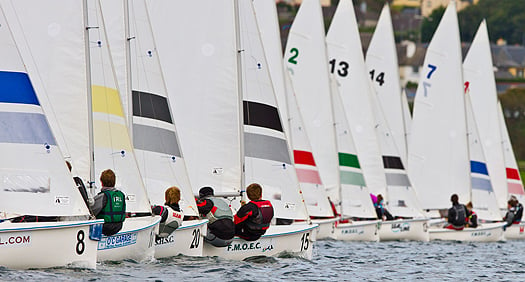
The TR3.6 dinghy fleet in action. Photo: Brian Carlin
Meanwhile Finn Lynch from the National Yacht Club and Eoin Lyden from Royal Cork Yacht Club had been fighting it out for the silver. Finn had a four point lead going in to the medal race but the 2012 ISAF Youth Worlds silver medallist had a disastrous final race finishing in 10th place. The additional 20 points meant he dropped to third overall to take the bronze.
Eoin however sailed a great race finishing in second place moving him up to second overall to take the silver.
Competing for the title of First Girl were Aisling Keller from Lough Derg and Laura Gilmore from Northern Ireland. Both girls had sailed a strong regatta with a total of nine top 10 finishes between them but ultimately a 4th in the medal race for Aisling saw her finish the regatta in 7th overall taking the prize for Frist Girl with Laura finishing in 9th overall.
Lyden Takes Early Lead at Junior All Ireland Sailing Champs
#youthsailing – Fionn Lyden and Anna O'Regan from Schull Community College Sailing Club lead the All Ireland Junior Championships in Schull this evening. Download full results as pdf below.
The Current European U17 Laser Radial champion Finn Lynch from the National Yacht Club crewed by Sean Donnelly finished second in four of the races is four points adrift on 8 points overall. In third place and on 16 points is Eoin Lyden and Darragh McCormack from Royal Cork Yacht Club.
The invitational regatta saw 21 of Ireland's top young sailors take to the water in TR3.6 dinghies for the initial five races. A further three more races are schedlued for tomorrow followed by a double points medal race decider for the top 10 sailors.
ISAF Youth Silver Medalist in Action at West Cork Junior All Ireland Event
#youthsailing – Ireland's silver medal winner from the ISAF youth worlds will be back on the water again at the Junior All Ireland Sailing Championship this weekend. Racing takes place at the Fastnet Marine OEC in Schull, Co. Cork in a fleet of locally built TR3.6 dinghies.
Laser Radial sailor Lynch of the Natinoal Yacht Club who is the reigning U17 Laser Radial European Champion will be joined by rival Laser sailors Robbie Gilmore, Fionn Lyden and Seafra Guilfoyle as well as numerous other youth sailors, across seven classes, with national and international experience.
Each competitor will sail with one crew member of their choice in one of the TR3.6 dinghies. Following an optional practice day on Friday, all sailors will compete in up to five fleet races on Saturday. Up to a further three races will be sailed on Sunday with one additional final double points medal. Upon the completion of five fleet races, one discard will come in to play.
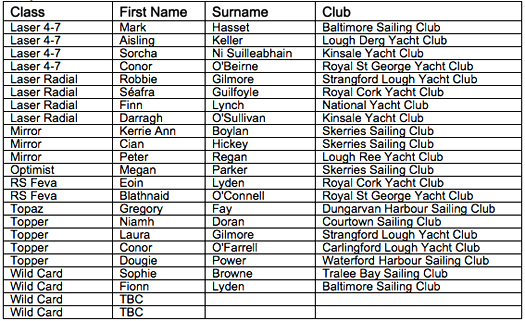
West Cork Calves Week 2012 Keeps the Best 'til Last! (Photos Here)
Cork Dry Gin Calves Week at Schull, West Cork, certainly kept the best til the last writes Claire Bateman. Scroll down for Photos.
Given the fog and poor visibility experienced during the early part of the regatta week, the organisers made the wise decision to switch the Fastnet race to Friday and what a day it turned out to be. There was a beautiful warm easterly breeze force 4/5 with non stop sunshine. Race Officer Neil Prendeville reversed the order of the start so that the lower handicapped boats started first and off went all the classes of the sixty boat fleet to enjoy a day the like of which has not been experienced for a long, long time and certainly not this year. The wind, which was coming from the east, meant that instead of a start directly into the wind what they had was a reaching start and by the time it came to the Class Two and Three start they charged the line some believing that the buoy safeguarding the stern of the committee boat was an inner distance mark.
Both the Corby 25 Allure and the quarter tonner Per Elisa returned to start again before proceeding on a course that took them up Long Island Sound under spinnaker, seven and eight abreast, and what a sight that was, before taking Goat Island to port and then a fetch to the Fastnet which course was also followed by the Class One boats. Being a Fastnet race with the magnet of rounding the famous rock, the boats as usual were packed with not only racing crews but there were also a lot of families on board from Grannies and Grandads to babies and even some canines, all having the time of their lives in the brilliant sun and white capped seas.
In a race like this taking in the Fastnet with the tidal sweep around it throwing up a lumpy sea it was inevitable there would be one or two incidents and one of these saw the Travers/Rohan quarter tonner Per Elisa doing a pirouette much to the astonishment of her helm and crew only to find their rudder had loosened and one of the other boats came to her assistance. There were one or two other coming togethers in the tight racing and Pat Barret/Cathal Conlon in Y knot came in to the finish on a tight spinnaker reach and experienced great difficulty in dropping their big red kite trying everything from going backwards and forwards and even sending a crew member up the mast to try to free it which they eventually succeeded in doing.
In the midst of all this enjoying the glorious weather and sailing spectacle of the sixty boat fleet the cruise ship Hebridean Princess was arriving in Schull Harbour and the gentlemanly Master called the Race Officer to ascertain the situation and having it explained to him the race would last approximately anther hour, brought his ship around Long Island through the Gascanane Sound to anchor at the mouth of the harbour thus enabling his passengers to have the unexpected treat of viewing the racing in the unbeatable scenic surroundings.
In Class One IRC Kieran Twomey's "Gloves Off" returned to her winning form with a tight twenty second victory over Martin Breen's "Lynx Clipper.This result confirmed " Gloves" as IRC One overall boat of the week.
In Class One ECHO it was another popular win for Gabby Hogan's "Growler" that also saw him take the overall trophy.
In Class Two IRC Jason Losty finished a fantastic week in runaway style with a comprehensive victory to take both the day prize and overall trophy, when his closest competitor the Travers/Rohan "Per Elisa" had to retire due to the already mentioned gear failure.
In Class Three IRC Derek Dillon posted another perfect score to comfortably win the overall from Dan O' Donovan's "Second Count",while in ECHO victory went to local Schull boat Paul Murray's "Full Pelt".
In Class Four it was a clean sweep in both divisions for the Murphy family in "Shelly D" while the overalls went to Richard Hanley's "Saoirse"in IRC and the Molloy/O' Shea duo on "No fixed Abode", who despite a disqualification in the final race, won the ECHO trophy.
In White Sail One Michael O Leary's "Act Two" revelled in the fresh conditions to win in both divisions and also took the ECHO overall while William Lacy and Charles Blandford in "Sojourn" collected the IRC trophy.
In White Sail Two Michael Hearn in "Summerfly" had a brilliant trip around the rock to win from Brian Ronan's "Kopper Too" with the overall going to Peter Morehead of the sponsor company, Cork Dry Gin, in "Giggles".
All in all a perfect ending to Cork Dry Gin Calves week 2012.
West Cork Calves Week to Welcome 60 Yachts
#calves week – With over 40 confirmed entries at present, the 2012 Calves Week in Schull is again expected to top the 60 boat mark for the annual West Cork festival of sailing.
This year's event will incorporate a race in the Scora Offshore Series and will feature racing for six classes with the ever growing white sail class split into two fleets and with a cut-off point of approximately 34ft.
The traditional overnight Offshore Scora race starts from Crosshaven on Friday night, August 3rd, while on Sunday the Schull/Baltimore regatta feeder race will provide ample opportunity for skippers and crews to familiarise themselves with Roaring Water Bay where principal race officer for Calves Week, Neil Prendeville, has drawn up a new course card featuring over forty courses taking in the many islands and natural marks.
The opening reception and skippers briefing takes place at the Fastnet Marine Centre on Monday August 6th with the first "Round the islands" race starting at 12.30pm on Tuesday.
On Wednesday the fleet will sail two races on an Olympic type course in Long Island Bay, while Thursday will see the boats head for the Fastnet Rock .
The series will finish on Friday with racing in Roaring Water Bay followed by the overall presentation of prizes and closing ceremony on Schull Main Street.





























